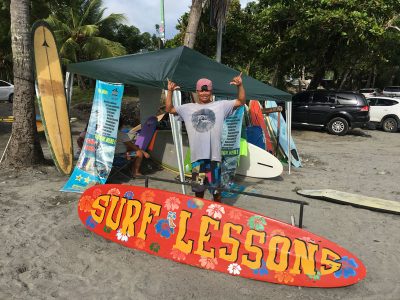What to Check for When Renting a Surfboard
 By Greg Gordon, CR Surf Travel Company
By Greg Gordon, CR Surf Travel Company
www.CRsurf.com @crsurf
This article is mostly for beginner surfers or those taking a surfboard out for the first time. You see a lot of options on the beach for board rentals, in both sizes and prices. So which is the best for you? Well that depends on the size and type you need, the condition of the board, leash, and fins, and the price you want to pay.
Size and Type
If you are beginner you are going to want a longer board. An official ‘longboard’ is 9 feet long, and most anyone under 200 lbs can easily float on it. Bigger surfers should look for wider or longer boards, but not too long. Really long boards can get heavy and hard to control in waves over knee to waist high. If you are a smaller or lighter person, you can choose a board as small as 7’6” but smaller boards are generally thinner and will not float you as well. They also turn quickly so are less stable. Even kids should get longer boards (7’6” to 8’) since the goal is being able to stand up easily, that is the fun part. Kids get frustrated and lose interest if they keep falling down.
The two main types of boards are solid or soft-top. Solid boards are harder and float a person a little better. The down side is you want to have a good coat of wax on the board so your feet and stomach don’t slip. Also it can hurt should it hit you in the head or body. Soft-top boards are the same weight, but they have a spongy top. For most of them you do not need wax to grip the top of the board. However, the sponge like surface can cause some painful rashes on your chest, stomach, and the insides of your thighs when sitting on it.

Overall you want the board to be wide (over 21”) and thick (over 3”) for an adult if you are learning so you can catch waves easier. It provides for a more stable surface to keep your balance on.
Previous Damages
So once you picked out a board you want to look it over for damages. The first reason is so the owner doesn’t charge you later for putting a ding on the board. And second is so a crack along the side of the board doesn’t cut you while in the water. Third is so a hole in the board doesn’t fill up with water, causing the board to get heavier. To check for dings (damages), feel both rails (the sides) of the board with your hand and pause where it feels rough. Some dings might have been fixed, but the owner did such a bad job that the repair is sharp and can hurt you if you hit it. Also, if there is a repair that crosses the entire width of the board, don’t rent it. This means the board was broken, and even when fixed would be a lot heavier and not good for learning.
Leash and fins
After checking the board itself, look at the fins. First, look to see they are all the same size; at least the two side fins should be equally sized. The center fin can be longer. A board with no center fin is harder to steer. Check to make sure all the fins are tightly secured. There are usually one or two tiny hex screws holding them in. Check the fins are not bent or have big cuts in them, or have been worn down by being dragged in the sand.
Then examine the leash. Starting where it connects with the board check that the cord is in good condition and not frayed. Then look at the leash itself to check there are no knots in it. A knot will eventually cause the leash to break, and that is not fun while you are in the ocean. Finally check where it connects to your ankle and determine if the Velcro is still in good condition so you can secure it around your ankle without it coming off.
Prices
When you are on the beach, you have options if you just walk another few yards. Most board rentals start at $10 for two hours, and most of the boards I’ve seen in Manuel Antonio are not in good shape. They have been abused by too many beginners. If you are asked to pay $15, then the board and leash should be in excellent condition, with only minor dings on the surfboard. And if you pay $20, then you should be getting a newer shape that is just the size and type you want, in excellent condition, and you should be able to keep it 24 hours. Most renters will ask to hold a credit card or driver’s license, so make sure you bring one of them with you when heading to the beach.
